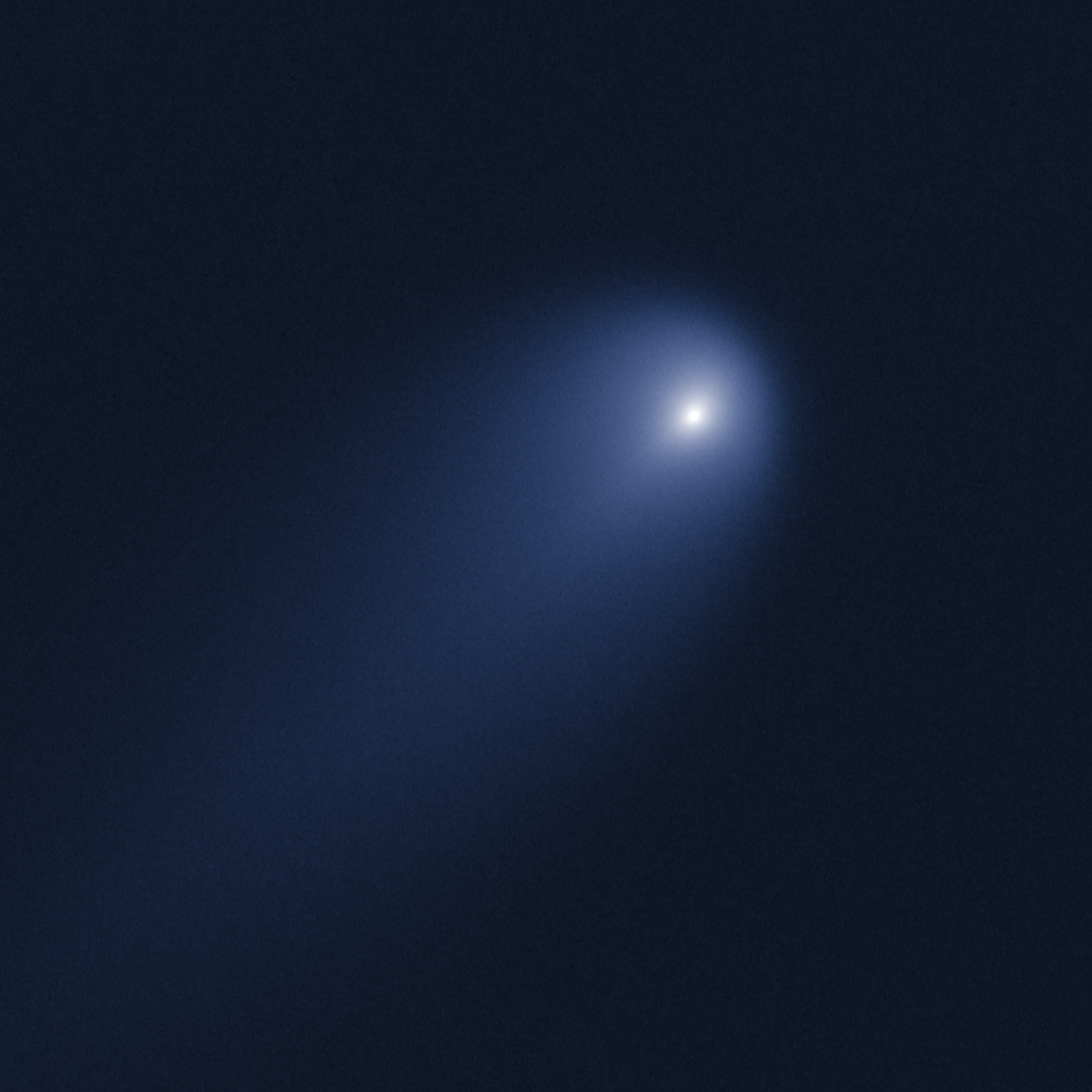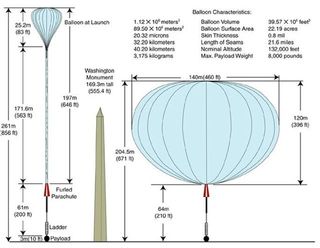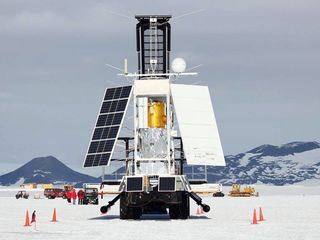Scientists to Eye Potential 'Comet of the Century' with Balloon Mission

This story was updated 5:34 p.m. EDT.
Scientists are working to loft science gear by balloon to observe the fast-approaching Comet ISON, which could be one of the brightest comets ever seen when it blazes through the inner solar system this fall.
The project, called Balloon Rapid Response for ISON (BRRISON), aims to get high-quality views of Comet ISON, which experts say could shine as brightly as the full moon when it makes its closest pass by the sun in late November.
The sky-high BRRISON project also hopes to demonstrate that important planetary science questions can be addressed with a balloon platform, researchers say. It will be the first planetary-science balloon mission since 1963, when a Stratoscope II balloon lifted off to observe planets, stars and galaxies. [Photos of Comet ISON in Night Sky]
A large helium-filled balloon will tote a gondola packed with a telescope and other equipment to near space, soaring up to 120,000 feet (36,576 meters) altitude — almost 23 miles (37 kilometers) above the Earth. The BRRISON balloon's gondola will carry infrared and near ultraviolet/visible imaging gear, along with fine steering mirror technology to obtain high pointing stability.
BRRISON is to be launched from the Columbia Scientific Balloon Flight Facility at Fort Sumner, N.M., in the September-October timeframe on a one-day observing trek.
Super pressure
Get the Space.com Newsletter
Breaking space news, the latest updates on rocket launches, skywatching events and more!
The BRRISON project, which is being sponsored by NASA, The Johns Hopkins University Applied Physics Laboratory (APL) and the Southwest Research Institute, is moving fast, because time is of the essence.
Comet ISON — officially designated C/2012 S1 (ISON) — was just discovered in September 2012, by Russian amateur astronomers Vitali Nevski and Artyom Novichonok.
"We will be going from discovery of Comet ISON to start of the launch window for the balloon within one year," said Andrew Cheng, BRRISON principal investigator and chief scientist in the Space Department at APL in Laurel, Md.
Work on BRRISON has been underway since early February, Cheng told SPACE.com. "It's the fastest I've ever run in my life, he said. "From confirmation to start of the launch window, we will have six months. That's mighty fast, even for us, but the comet won't wait."[Amazing Comet Photos by Skywatchers]

Thin atmosphere
Instrument-carrying high-altitude balloons can deliver cost-effective science, a high priority in this era of tighter budgets, said BRRISON team member Eliot Young, a principal scientist at Southwest Research Institute in Boulder, Colo.
Earth's atmosphere is thin up at BRRISON's observing atmosphere, Young said.
"You can compete with the Hubble Space Telescope for getting sharp images, but at a tiny fraction of the cost," Young told SPACE.com.Young told SPACE.com.he Hubble Space Telescope for getting sharp images, but at a tiny fraction of the cost,"to 140,000 feet al The science equipment is divided up into two benches, "stacked like a wedding cake," he added.
Along with Comet ISON observations — depending on expected duration of the balloon flight — other celestial targets may come into focus, such as Asteroid Elektra, Comet Encke and two bright double stars in the handle of the Big Dipper, Young said.
Challenges
With the clock ticking, and Comet ISON clicking off mileage, the BRRISON team faces some challenges, Young said, such as matters of thermal control and the pointing accuracy of science-gathering instruments in the gondola.
"It's very similar to hanging an SUV from a 300-yard cable," Young said. "The good news is that wind disturbances in the stratosphere are, by and large, pretty benign."
With launch day only a few months away, the anticipation is building. "Balloon liftoffs are magical moments," Young said. The race to get BRRISON off the ground and get Comet ISON in view "is stressful ... but fun," he said.
"BRRISON is absolutely unique in terms of what we're going to measure at the comet. There's nothing else that can do it right now," Cheng said. "There are space telescopes, but none of them happen to be in the right place at the right time ... and there isn't enough time to build something new. With a balloon, it's doable."

Sungrazing comet
An Oort Cloud comet believed to be making its first trip to the inner solar system, Comet ISON's perihelion — or closest approach to the sun — occurs Nov. 28, when it's projected to skim about 730,000 miles (1.2 million km) above the solar surface. There's no guarantee ISON will survive this perilous passage intact, but BRRISON will observe the comet before perihelion.
BRRISON is geared to measure carbon dioxide and water, primary cometary volatiles. Found as ices in a comet’s nucleus, they drive cometary activity. Scientists want to know whether the abundances of these volatiles are related to where comets formed, what they formed from and how they evolved.
Cheng said that most of the data gleaned by BRRISON will be recorded onboard and analyzed after landing.
"We'll also have immediate downlink data so we'll know on the spot how things are working," he said.
Target of opportunity
Comet ISON is an important target of opportunity, Cheng said, to study volatile-rich material from the epoch of planet formation; to learn how comets work; and to find clues to the origins of the solar system.
Furthermore, BRRISON will develop and demonstrate gondola and payload systems for a balloon-borne platform designed to achieve a range of planetary science objectives, Cheng added. BRRISON's gondola is designed to protect the payload during nominal recovery back on the ground, he said, enabling re-use.
"We're making new observations of an object that has never been observed before in the wavelengths we’ll have. We've got to learn something new and exciting," Cheng said.
Editor's note: If you capture an amazing photo of Comet ISON or any other night sky sight that you'd like to share for a possible story or image gallery, please contact managing editor Tariq Malik at spacephotos@space.com.
This story was corrected to reflect the fact that the BRRISON mission will fly on a Zero Pressure balloon, not a Super Pressure balloon.
Leonard David has been reporting on the space industry for more than five decades. He is former director of research for the National Commission on Space and is co-author of Buzz Aldrin’s new book "Mission to Mars – My Vision for Space Exploration" out in May from National Geographic. Follow us @Spacedotcom, Facebook or Google+. Originally published on SPACE.com.
Join our Space Forums to keep talking space on the latest missions, night sky and more! And if you have a news tip, correction or comment, let us know at: community@space.com.

Leonard David is an award-winning space journalist who has been reporting on space activities for more than 50 years. Currently writing as Space.com's Space Insider Columnist among his other projects, Leonard has authored numerous books on space exploration, Mars missions and more, with his latest being "Moon Rush: The New Space Race" published in 2019 by National Geographic. He also wrote "Mars: Our Future on the Red Planet" released in 2016 by National Geographic. Leonard has served as a correspondent for SpaceNews, Scientific American and Aerospace America for the AIAA. He has received many awards, including the first Ordway Award for Sustained Excellence in Spaceflight History in 2015 at the AAS Wernher von Braun Memorial Symposium. You can find out Leonard's latest project at his website and on Twitter.